9. 1 INTRODUCTION
Since the Middle Paleolithic context was first established through extensive investigations at sites such as Tabun and Yabrud, dozens of succeeding investigations have presented results that not only confirm but also modify the Middle Paleolithic context that was initially established. In regard to the Levantine Mousterian which is a separate component of the Middle Paleolithic sequence in the Levant, it has been noted that the frequency of the Levallois technique, which is one of the most important criteria in defining these assem blages, has a high degree of variability. Nevertheless, these assemblages usually have been reported under a single nomenclature: Levantine Mousterian or Levalloiso-Mousterian.
Skinner (1965) pointed out the possibility that the Levantine Mousterian industries ex- hibited great typological and technological variability. He divided the Levantine Mousterian into four groups: the Abou Sif type, the Tabun type, the Yabrud type, and the Ahmar type, and defined each type according to Bordes' scheme. Nevertheless, it is difficult to establish with certainty a mutual relationship between assemblages reported under the single nomenclature of the Levantine Mousterian according to these four types. Because the quantitative data presented by Bordes' scheme is not simple, it has proved difficult to com prehensively compare a number of assemblages together, and also to make use of the full range of data obtained.
Again, the collection from the Douara Cave brought to light important facts with regard to the Middle Paleolithic inter-assemblage variability in the Levant. As noted in the preceding chapter, the lithic material of Horizons IIIA, IIIB and IVB were identified both typo logically and technologically as belonging to the Middle Paleolithic context of the Levant. At the same time, it was found that these assemblages exhibit great typological and tech nological variability among themselves. That is to say, the assemblages of Horizon III are seen to match with those of the Levantine Mousterian, while the underlying Horizon IVB is not similar to any known assemblage identifiable as Levantine Mousterian. The next stage is to compare the industries from the Douara Cave with other Paleolithic assemblages from relevant sites in the Levant. This procedure should provide the basic data necessary for clarifying the significance of the Middle Paleolithic inter-assemblage variability, and moreover, for placing the Douara material in the established sequence of Paleolithic indus tries in the Levant.
9. 2 MATERIALS
The materials studied in this paper consist of 71 lithic assemblages found
in stratified deposits of three sites: at the Douara Cave and Yabrud Shelter
I both in Syria and at Combe- Grenal in France (Table 9. 1). Yabrud Shelter
I was excavated by Rust (1950); the lithic assemblages were re-analysed by
Bordes (1955). Combe-Grenal was excavated and analysed by Bordes (Bordes et
al., 1966). The selection of these sites was due to the fact that both had
been fully studied by Bordes, and therefore we can assume a set of entirely
standardized data under a uniformly controlled classificatory system. The
original data of Yabrud and Combe-Grenal were kindly presented by Professor
Bordes.
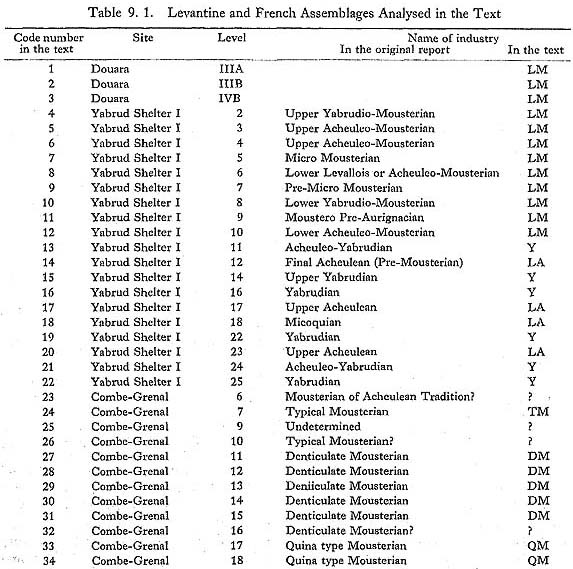  |
The assemblages classifiable under the two major categories of the Middle Paleolithic and the preceding Acheulean industries are further subdivided into several specific assem blages as defined by Bordes and others.
Yabrud material
The nineteen assemblages of Yabrud Shelter I fall into three groups: Levantine Mous terian, Yabrudian and Late Acheulean. The original nomenclature proposed by Rust was rather complex with peculiar designations which do not wholly apply to other excavations in the Levant. Consequently, these three assemblage types have been broadly denned as follows (Rust, 1950; Bordes, 1955; Skinner, 1965):
(1) Levantine Mousterian
This group contains a large number of unretouched Levallois type tools (30 to 70 per cent): there are a moderate number of Mousterian type side scrapers and denticulates, and Upper Paleolithic type tools such as backed knives and burins are also moderate in number. However, there are no or very few handaxes.
(2) Yabrudian
This type of assemblage is characterized by a negligible percentage of Levallois type tools and a high percentage (more than 50 per cent) of side scrapers. The side scrapers are pre dominantly convex, transverse and dejete with much Quina retouching. Handaxes may or may not be present.
(3) Late Acheulean
This group is characterized by the presence of handaxes, side scrapers and denticulates. The frequency of Levallois type tools is variable (2 to 30 per cent).
Combe-Grenal material
The assemblages of Combe-Grenal, classified into the following six types, have been defined as follows (Bordes, 1961, 1972; Bordes et al., 1966).
(1) Mousterian of Acheulean Tradition (M.T.A.)
The Middle Paleolithic assemblages of this type are characterized by the presence of handaxes, side scrapers, denticulates and backed knives. These are further divided into two subtypes. Type A and Type B, according to the frequency of the tool types character izing this industry. In particular. Type A has higher frequencies of handaxes (8 to 40 per cent) of general cordiform and triangular forms; Type B has fewer handaxes (seldom more than 4 to 5 per cent) and those that are present are of different types and none are triangular. Type B is also characterized by having more backed knives and fewer side scrapers than Type A.
(2) Typical Mousterian
This group appears similar to the preceding M.T.A. Type A. There are side scrapers (25 to 55 per cent), some denticulates and notches, and well-made points. However, there are few or no handaxes and backed knives (0.5 per cent at most); this marks the significant difference from the M.T.A. material.
(3) Denticulate Mousterian
This group contains nearly 80 per cent denticulates and notches; side scrapers, scrapers, burins and borers constitute the remainder. In this group there are no handaxes, backed knives or points.
(4) Quina type Mousterian
Included in this group are many side scrapers (up to 75 per cent or more). Among these are many transverse and Quina type scrapers made on thick flakes with a distinct type of scaler retouch. Handaxes and backed knives are very few or nonexistent.
(5) Ferrassie type Mousterian
The percentage, of side scrapers is precisely the same as in the preceding Quina type Mousterian assemblage. However, in this group, a high frequency of usage of the Levallois technique is observed in the production of blanks.
(6) Upper Acheulean
Included in this group are a small number of handaxes (4 to 7 per cent) so far as the Combe-Grenal assemblage is concerned. Together with these, there are many side scrapers (25 to 40 per cent), and some denticulates (around 10 per cent). However, Upper Paleo lithic type tools are of a low frequency: in particular, backed knives are nonexistent or negli gible in number.
Douara material
The collection of the three stratigraphic units, IIIA, IIIB and IVB, from
Douara were reclassified according to Bordes' scheme for the purpose of comparing
them with the Yabrud and Combe-Grenal material under the same standard (Table
9. 2), In the reclassifi cation, the three Douara assemblages closely resemble
each other, although some slight differences can be observed. Further, the
assemblages can be broadly identified as belonging to the Levantine Mousterian,
since they are all characterized by the dominance of Levallois type tools,
but with very few tools of other types.

The original data were composed of the relative frequency of tool types classified under the list of 63 standard types designed by Bordes. Bordes' classification data are usually used in two ways: essential and real. In this case the second form of data, which includes all the tools, was used. Accordingly, the following analysis was performed based only upon the typological characteristics of the Uthic assemblages. Moreover, many assemblages, except for that of Douara, contain few if any bifacial elements. These bifacial elements classifiable as handaxes, with their morphological features and proportion in the assemblage, are usually used as an important criteria in identifying those assemblages. However, in the present study, these elements are excluded.
9. 3 METHODS OF ANALYSIS
The methods employed to attain the goal described in the introduction were factor analysis and distance analysis; they were selected for the purpose of clustering the related assem blages of the Douara Cave.
Prior to executing the analysis, the following data processing was carried out.
1) Factor analysis: the raw data given in the form of frequencies were transformed
into angles using the formula
where θ is the transformed value, and p is the frequency. As a result of this procedure, the distribution of the given data approximates the normal distribution.
Factor analysis was executed on the basis of the correlation matrix between 61 variables, and the rotation of the axes was carried out by the varimax method.
2)Distance analysis: The method of calculating distance coefficients used in this study was that devised by C.A.B. Smith (Berry and Berry, 1967) for processing frequencies of discrete characters.
The formula for calculating the distance is
where θIi=sin–1 (1-2 pIi), pIi is the frequency of the i-th character in assemblage I, nI stands for the sample number in the same assemblage, and N is the number of characters involved.
In addition, the variance of D can be obtained by the formula
The dendrogram shown in Fig. 9. 5 was drawn on the basis of Smith's distance
coeffi cients using the group-average method.
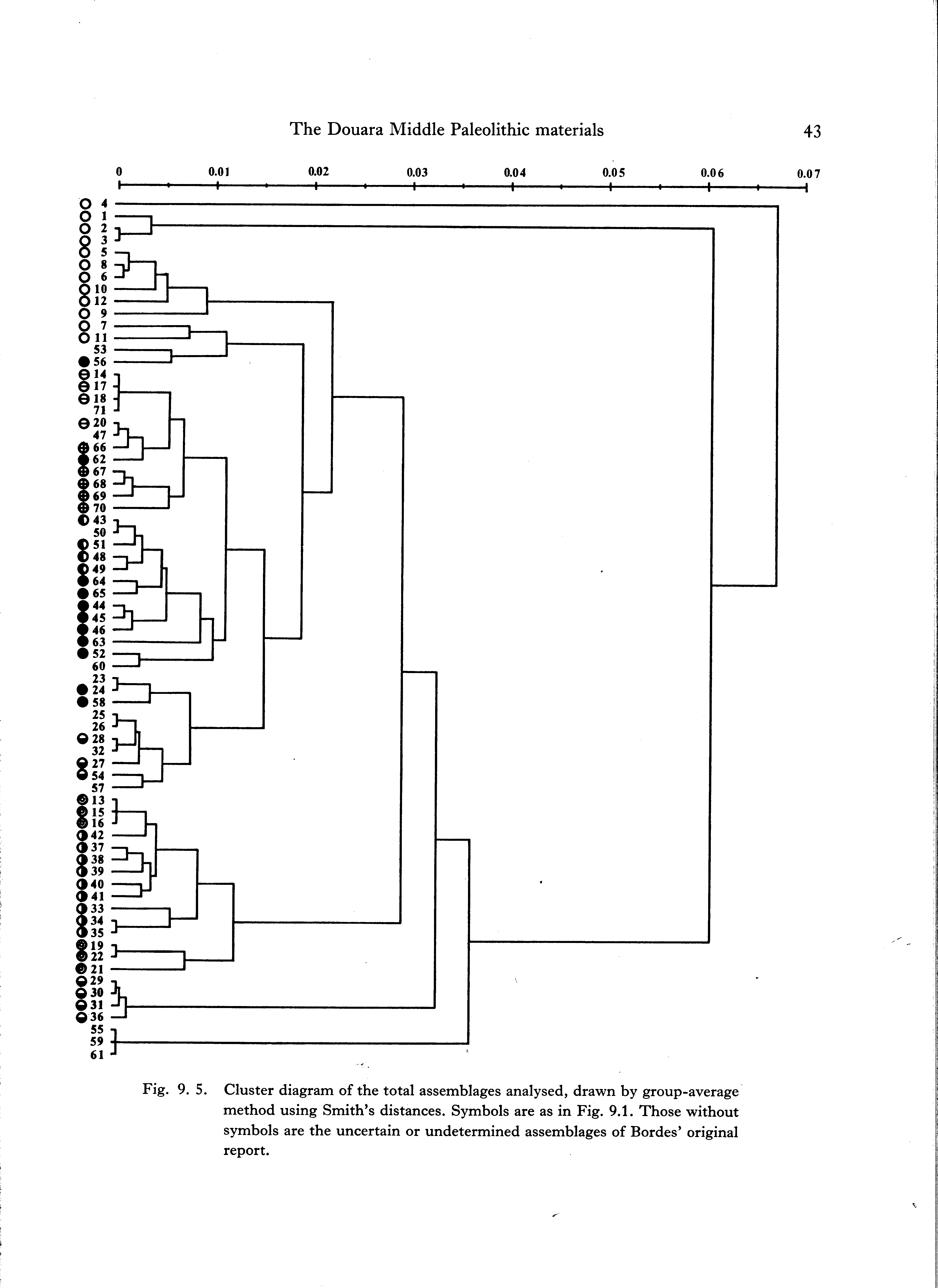
The computations were processed by the OS-7 system of the University of Tokyo Com puter Center using the FORTRAN programs CFACTR for the factor analysis and NONMET for the distance analysis. The former program is contained in HSAP (Hitachi Statis tical Analysis Program) and the latter was coded by Kazuro Hanihara.
9.4 FACTOR ANALYSIS
Table 9. 3 shows a list of the standard tool types used as variables, arranged
according to the corresponding factor loadings. The table is divided into
five major groupings of vari- ables, exhibiting higher correlations as they
occur in each factor (five, in this case). The standard tool types excluded
from this table indicates that the factor does not show signif icantly high
correlation with the excluded tool type, showing low values ranging from +0.5
to –0.5 in the factor loadings. As a result, it was found that a set
of standard tool types can be used as diagnostic of each factor.

The first group of variables (14 standard tool types) was selected as diagnostic of Factor 1. Among these variables, Levallois flakes of two types show positive values while the remainder, consisting of various side scrapers, have higher negative values.
In the case of Factor 2, the second group of variables (8 standard tool types) was taken as diagnostic of this factor. These variables were also divided into two groups. Four types of tools, notch, denticulate, diverse and Tayac points, show positive values, but various points and convergent straight side scrapers, and the typical Levallois flake included in the first group of 14 tool types show higher negative values.
Diagnostic variables for Factor 3 consist of four types of side scrapers constructed on ventral surfaces, pieces retouched on the ventral surface, and typical and atypical burins. All these show positive values.
The fourth group of variables, containing typical and atypical perforators and bec burinant alterne, can be considered diagnostic of Factor 4. Again in this case, all have positive factor loading values.
In the final factor, the two variables consisting of naturally backed knives and abrupt or alternate retouched pieces are considered diagnostic. Factor loading values are different in each case: the first is positive and the second is negative.Figures 9. 1 through 9. 4 show the distances between the analysed lithic
assemblages delineated by the mean factor scores calculated for each assemblage
on the basis of the factor loadings. These figures closely resemble each other,
although some slight differences can be observed among them.
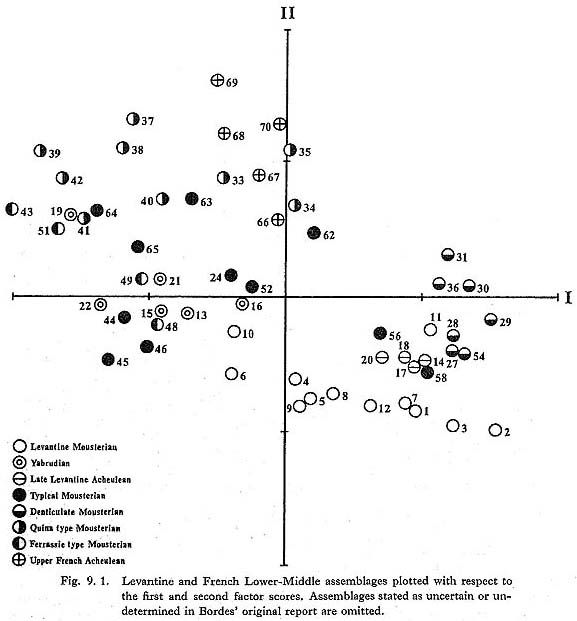
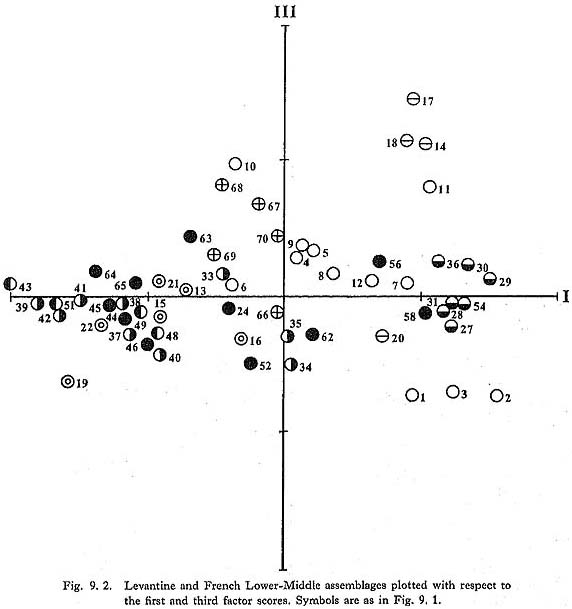

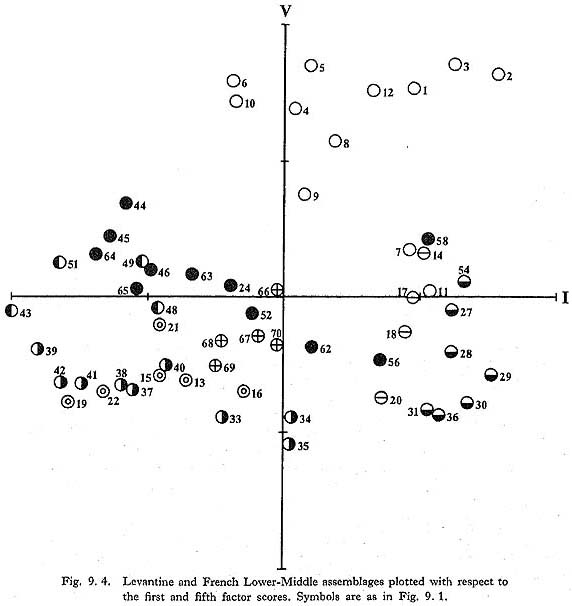
First we can see, in general, a separation of assemblages along the Y-axis, On closer examination of these two major clusterings, the group clustered on the right side consists of the three assemblage types classifiable as Levantine Mousterian including the Douara material, the Late Levantine Acheulean, and the Denticulate Mousterian in France. The other group contains French Mousterian of all types, Upper French Acheulean, and Yabrudian from the Levant. These two groupings of assemblages will be further examined through the original data used in the present analysis.
The three assemblage types clustered on the right side are all characterized by showing low frequencies of side scrapers, and by having moderate to large quantities of Levallois or denticulated type tools. On the contrary, the left-hand group consists of assemblages characterized by having high frequencies of side scrapers of various types as their main lithic constituent. These general typological features of the two clusters agree with those of the Factor 1 and Factor 2 diagnostic variables outlined above. In particular, the various side scrapers, which exhibit significantly high factor loadings in Factor 1 and which can be considered diagnostic of this factor, can be understood to sort these assemblages into two clusters.
Next, each of these two major groups was further separated into smaller clusters. The assemblage group on the right side falls into three clusters: the Levantine and Denticulate Mousterian, and the Late Levantine Acheulean. Moreover, the Levantine Mousterian is further grouped into two clusters: Yabrud and Douara. In general, the grouping is clear, although the distance between the clusters is variable as is shown in the four figures.
As mentioned before, the assemblages constituting these clusters are generally charac terized by high frequencies of Levallois type tools, or by irregularly retouched and utilized flakes such as notches and denticulates, and of low frequencies of regularly transformed Hake tools such as side scrapers. But the actual frequencies of these tool types are distinctly dif ferent in each assemblage. Among these differences, it is noted that the Douara material is characterized by an exceedingly high proportion of Levallois type tools, and of very low frequencies of side scrapers and denticulates. As a result, the Douara material formed a single group at a different cluster level from the others.
On the other hand, the assemblages constituting another major group, broadly located on the left side, show a rather complex separation. Although the Upper French Acheulean shows concrete evidence of clustering, the other five types of assemblages classifiable as French Mousterian and Yabrudian show a wide range of distribution and overlapping. In particular, distribution of the Typical Mousterian assemblages is peculiar, characterized by overlapping with assemblages classified as another major group on the right side. This suggests that these assemblage types have more complex features, and therefore cannot be explained simply on the basis of typological characteristics.
However, it is interesting that Yabrudian assemblages broadly overlap assemblages classi fied as Mousterian of Quina and Ferrassie types, although their actual geographical distri bution is distant from the two. The overlapping observed here agrees with a close relation ship between the Yabrudian and Quina groups noted by Bordes (Bordes, 1977).
The results obtained by factor analysis have shown that the clustering of the lithic assem blages analysed in this case depends mostly on the frequencies of side scrapers, and of Levallois and denticulate tools. That is to say, the well-observed separation into clusters is mostly concerned with the assemblage types defined by increased frequencies of side scrapers, Levallois or denticulates.
9. 5 SMITH'S DISTANCES
Taking the same data used in factor analysis, Smith's distances were calculated by pairing the 71 assemblages. Figure 9. 5 is the dendrogram drawn from Smith's distances by the group-average method. It shows clear evidence of assemblage clustering. The observed separation into clusters agrees with a sorting of assemblages into industrial groups designed by Rust and Bordes. That is to say, in nearly all cases the lithic assemblages classifiable as belonging to the same industry are located closely to each other, and exhibit clear clus tering.
In comparing these separations with the results obtained in factor analysis, almost identical clustering patterns can be seen. For example, the assemblages classified as typical Mous terian fall into several cluster groups of quite different industrial assemblages, just as is seen in the case of Typical Mousterian assemblages which show a wide range of distribution in factor analysis. However, the overall pattern of separation is more positive than that of factor analysis.
First, the lithic assemblages seem to form several clear clusters: a late Levantine-French Acheulean group, a Typical-Ferrassie type Mousterian group, a Typical-Denticulate Mousterian group, a Yabrudian-Quina type Mousterian group, and a Denticulate Mouster ian group. Among these, it should be noted that both Yabrudian and Quina type Mousterian represent a single cluster. Although the geographical distribution of these two industries is quite different and the chronological relationship between them is not yet clear, they con stitute a single cluster separated from the other groups so far as the present analysis is concerned. This separation agrees well with a relationship between these two assemblages referred to by Bordes (1977), as the Yabrudian-Quina equivalent.
The above Yabrudian-Quina type Mousterian group is clearly separated from the three other clusters mentioned previously: those represented by Levantine-French Acheulean, Typical-Ferrassie type Mousterian and Denticulate Mousterian assemblages. Placing this clear separation into two major clusters on the basis of the original data used here, it was found that this separation is mostly due to increases in the number of side scrapers or unretouched Levallois type tools, as in the case of factor analysis.
The separation of Denticulate Mousterian assemblages into two clusters is different from that seen in factor analysis, whose results showed that the assemblages classifiable as Den ticulate Mousterian were all located close to each other and showed clear clustering. Examin ing this discrepancy through the original data, it seems that the separation pattern observed in clustering analysis based upon Smith's distances is more positive than that of factor analysis. The assemblages classified as Denticulate Mousterian fall into two groups according to the frequency of Levallois type tools. The observed separation into two clusters agrees with a sorting of Denticulate Mousterian assemblages into one with a high frequency of Levallois tools and the other with none or a very low frequency of Levallois tools. The former exists in a large cluster together with Typical and Ferrassie Mousterian types characterized by a general presence of Levallois type tools. The remainder forms another cluster distinguished from any other assemblage group, generally characterized by having lower frequencies not only of Levallois type tools but also of side scrapers.
The assemblages classified as Levantine Mousterian fall into four groups: Douara assem blages, Yabrud 3, 4, 6, 7, 8 and 10 assemblages, Yabrud 5 and 9 assemblages, and the Yabrud 2 assemblages. This clear separation was not fully observed in the results from factor analysis. These clusterings cannot be fully explained with present knowledge, but some theorizing should be attempted.
The great separation between Yabrud 2 and other Yabrud assemblages belonging to Levantine Mousterian cannot be explained since the former assemblage was not distin guished from others in either the results of Bordes' (1955) techno-typological study or the factor analysis described in this paper. In these two studies, the Yabrud 2 assemblage makes a single group together with the 3, 6, 7, 8 and 10 assemblages belonging to Levantine Mousterian. In regard to the relationship between the Yabrud 2 assemblage and other Levantine Mousterian assemblages from Yabrud, the results obtained from factor analysis were more reasonable than those from Smith's distances.
The two assemblages from levels 5 and 9, shown in a single clear cluster, are distinguished from the other Levantine Mousterian assemblages of Yabrud, and designated by quite different nomenclatures, Micro-Mousterian and Moustero Pre-Aurignacian respectively. They are both characterized by lower frequencies of side scrapers, clearly seen in the index of side scrapers of around 5 (Bordes, 1955). They are also characterized by low frequencies of Levallois type tools, as compared with other Levantine Mousterian assemblages. In short, it is found that the above-mentioned tendencies sorted the Levantine assemblages of Yabrud into a level 5 and 9 group, and a group containing the other levels.
9. 6 SUMMARY
In comparing the Douara collection with the other assemblages analysed here, the results obtained from factor analysis exactly match the relationship between the Douara and the other assemblages that was assumed on the basis of Bordes' classification scheme. The Douara material is broadly closer to the Levantine Mousterian assemblages from Yabrud, in particular to the assemblage group consisting of levels 2, 3, 4, 6, 7, 8 and 10. These levels are all characterized by having high frequencies of Levallois type tools. But, the frequency of other tools such as side scrapers and denticulates is markedly distinct between Douara and Yabrud. This difference may be the cause of the assemblages' separation into two clusters; one for Douara and the other for Yabrud, although both clusters are located close to one another on the charts.
On the other hand, the assemblages from Douara and Yabrud were completely separated into two different groups by cluster analysis on the basis of Smith's distances. Another im portant result in regard to the Douara assemblages is that the two distinct assemblages exhibiting great typological and technological variability, one from the third horizon and the other from the fourth horizon, are physically located close to one another; there is no significant distance between them.
These contradictions may be due to variable features used in the present analysis. The original data were only variables of the "real" frequencies of implements classified according to the list of 63 standard types designed by Bordes. That is to say, the method used con centrated upon variable features of typological groups of lithic assemblages calculated by Bordes' scheme. However, his classification system actually contains another important variable, this being designated as the technological characteristics of assemblages.
The variability observed among the Douara assemblages is greatly reflected in the core techniques and the production techniques of blanks on which tools are made, that is, the technological characteristics of the assemblages. Variables characterizing these features were excluded from the actual analysis, which might affect not only the Douara assemblages' separation into clustering but also all the results obtained here.
Again, such a contradiction may be considered as an inevitable consequence of classifying lithic artifacts by means of non-metric standards such as that devised by Bordes and asso ciates. That is, a flexible classification system has an overt effect upon identifying the variability of lithic assemblages, although it is certain that it provides a means for uniformly describing lithic assemblages and improving the efficiency of comparative studies of assem blages. In the present study, the Douara data were not calculated by Professor Bordes, although the other data were all well-documented by him.
Acknowledgments
We would like to express our gratitude to professor Francois Bordes of The University of Bordeaux for providing valuable raw data of Yabrud and Combe-Grenal. His kind co operation made possible the comparative study undertaken in the text. The acknowledg ment is also due to Mr. Yuji Mizoguchi of Department of Anthropology, National Science Museum, Tokyo, for making possible the use of cluster diagram (in Fig. 9. 5).
LITERATURE CITED
- Arensburg, B. and Bar-Yosef, O. (eds.) (1977)
- Eretz-Israel, 13: The Israel Exploration Society.
- Berry, A.C. and Berry, R.J. (1967)
- Epigenetic Variation in the Human Cranium. J. Anat., 101:361-379.
- Bordes, F. (1955)
- Le Paléolithique inférieur et Moyen de Yabrud (Syrie) et la question du Pré aurignacien. L'Anthropologie, 59: 486-507.
- Bordes, F. (1961)
- Mousterian Cultures in France. Science, 134: 803-810.
- Bordes, F. (1972)
- A Tale of Two Caves. Harper and Row Publishers, New York.
- Bordes, F. (1977)
- Que sont le Pré-Aurignacien et le labroudien? In: Arensburg and Bar-Yosef (eds.), 1977: 49-55.
- Bordes, J., Laville, H. and Paquereau, M.M. (1966)
- Observations sur le Pleistocene supérieur du gisement de Combe-Grenal (Dordogne). Actes de la Société Linnéenne de Bordeaux, 103/10: 3-19.
- Rust, A. (1950)
- Die Höhlenfunde von Jabrud (Syrien). Neumünster.
- Skinner, J.H. (1965)
- The Flake Industries of Southwest Asia: A Typological Study. Doctoral Dissertation, Columbia University.